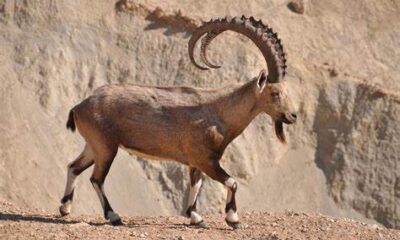Article
Pakistan: Guardian of Sacred Sikh Heritage
Published
9 months agoon
By
EDITOR
Pakistan is home to some of the most revered and historically significant sacred sites of the Sikh community. These places hold deep religious and cultural importance for Sikhs worldwide, and Pakistan, as their custodian, has played a key role in preserving and protecting these sacred sites. The country’s commitment to safeguarding Sikh heritage is a testament to its respect for the diverse religious and cultural traditions that have flourished in its land for centuries.
Nankana Sahib: Birthplace of Guru Nanak
Nankana Sahib, located in the Punjab province of Pakistan, is the birthplace of Guru Nanak Dev Ji, the founder of Sikhism. This city is the most sacred pilgrimage site for Sikhs around the world. The Gurdwara Janam Asthan, built to commemorate Guru Nanak’s birth, is one of the holiest Sikh shrines.
- Historical Significance: Guru Nanak was born in 1469 in this region, and his teachings laid the foundation of Sikhism. Nankana Sahib remains a focal point for Sikhs, who visit the site to pay homage to their revered spiritual leader.
- Religious Importance: Every year, thousands of Sikhs from around the globe gather at Nankana Sahib to celebrate Guru Nanak’s birthday, a major festival known as Gurpurab.
Kartarpur Sahib: A Corridor of Peace
Kartarpur Sahib, situated near the Indian border, is another sacred place for Sikhs. It is home to Gurdwara Darbar Sahib, where Guru Nanak spent the last 18 years of his life and where he was eventually laid to rest.
- Kartarpur Corridor: In 2019, Pakistan took a historic step by opening the Kartarpur Corridor, a visa-free route allowing Indian Sikhs to visit the gurdwara without a visa. This initiative was seen as a bridge of peace between Pakistan and India, symbolizing religious tolerance and respect.
- Religious and Cultural Importance: For Sikhs, Kartarpur Sahib holds immense emotional and spiritual value as it marks the final resting place of Guru Nanak, where he preached harmony, equality, and devotion.
Gurdwara Panja Sahib: A Miraculous Shrine
Located in Hassan Abdal, the Gurdwara Panja Sahib is another significant Sikh religious site in Pakistan. It is named after the sacred handprint, or “panja,” believed to have been left by Guru Nanak on a rock.
- Legend of the Handprint: According to Sikh tradition, Guru Nanak miraculously stopped a large boulder from rolling down a hill and crushing his disciple by placing his hand on it. The imprint of his hand remains on the rock, and Sikhs regard it as a sacred relic.
- Pilgrimage Destination: Panja Sahib is an important stop for Sikh pilgrims, especially during the annual Vaisakhi festival, a major religious event that celebrates the birth of the Khalsa.
Other Sacred Sikh Sites in Pakistan
Pakistan is home to several other important gurdwaras and sacred sites, each holding unique historical and religious significance for Sikhs. Some of these include:
- Gurdwara Dera Sahib in Lahore, the site where the fifth Sikh Guru, Guru Arjan Dev Ji, was martyred.
- Gurdwara Rori Sahib in Eminabad, associated with Guru Nanak’s travels and teachings during his early life.
- Gurdwara Sacha Sauda, also linked to Guru Nanak, located near the town of Farooqabad.
Pakistan’s Efforts in Preservation
Recognizing the importance of these sites, Pakistan has made significant efforts to preserve and restore them. Under the supervision of the Evacuee Trust Property Board (ETPB), the government ensures the upkeep of these sacred places, facilitating access for Sikh pilgrims and maintaining their historical significance.
- Restoration Projects: Pakistan has undertaken several restoration and maintenance projects to preserve the architectural and cultural heritage of these gurdwaras.
- Pilgrim Access and Hospitality: By opening the Kartarpur Corridor and facilitating Sikh pilgrims during religious festivals, Pakistan has demonstrated a commitment to maintaining its rich multicultural and religious landscape.
A Bridge Between Faiths
Beyond their religious importance, these Sikh sites in Pakistan serve as bridges of understanding and peace between communities. By maintaining and respecting the sacred spaces of Sikhism, Pakistan honors the shared history and cultural diversity of the region.
- Promoting Interfaith Harmony: The country’s stewardship of Sikh holy sites promotes interfaith harmony, fostering a spirit of inclusiveness and respect for all religions.
- Tourism and Pilgrimage: These sacred places are also contributing to religious tourism, drawing visitors from around the world and enhancing Pakistan’s reputation as a country that respects and protects its diverse cultural heritage.
Conclusion
Pakistan, as the custodian of some of Sikhism’s most important sacred places, has upheld its responsibility to preserve and protect this rich religious heritage. By maintaining and restoring these sites, facilitating pilgrimages, and promoting peace through initiatives like the Kartarpur Corridor, Pakistan continues to strengthen the bonds between the Sikh community and its own cultural and historical legacy. These sacred sites not only represent the spiritual heart of Sikhism but also stand as symbols of Pakistan’s commitment to religious tolerance and cultural preservation.
You may like
-


Unity, Faith, and Discipline: The Cornerstones of Pakistan’s Motto as “Aik Qaum” (One Nation)
-


“AIK QAUM” DECLARATION OF CONCEPTION
-


Dr. Abdul Qadeer Khan: The Real Hero of Pakistan
-


The Chiltan Ibex: A Rare Treasure of Balochistan
-


MANGO HEALTH BENEFITS NUTRITION
-


“Rising above the rugged terrain of Balochistan, Koh-i-Chiltan stands as a symbol of mystery and resilience.”
Article
Aik Qaum: The Fusion of Integrity and Patriotism
Published
3 weeks agoon
May 28, 2025By
EDITOR
We keep Integrity closest to our Heart and Patriotism on top of our mind.
Integrity and patriotism are not separate entities; they are intertwined in the soul of Pakistan. The people understand that to be a patriot is to uphold the principles of integrity. Honesty and love for one’s country are two sides of the same coin. Together, these values form the essence of “Aik Qaum.”
The fusion of integrity and patriotism is evident in the everyday lives of Pakistanis. It’s in the farmer toiling the fields, the teacher educating the youth, and the soldier guarding the borders. It’s in the child who dreams of a better Pakistan and the elderly who have seen the nation grow. “Aik Qaum” is the realization that integrity and patriotism are the heart and mind of Pakistan, beating in unison to guide the nation forward.
As we celebrate the spirit of “Aik Qaum,” we honor the values that make Pakistan a unique and resilient nation. Integrity and patriotism serve as our guiding stars, leading us towards a brighter and more prosperous future. In the heart of every Pakistani and at the forefront of their minds, “Aik Qaum” stands as a testament to the strength of a united nation, bound by the principles of integrity and the unyielding love for their homeland.
In Pakistan, “Aik Qaum” is not just a motto; it’s a way of life that embodies the enduring spirit of a proud and united nation.

Our Initiative
The fabric of the Pakistani nation has something unique in its knit, something signature and so sanguine that could keep on energizing its very fibers irrespective of the floods of considerably tough challenges posed against it since its inception. There is also a belief that Pakistan has been blessed with such a golden glitter that couldn’t be ignored by any sensible system of reason and knowledge among the league of free, upright and kind nations. The credit goes to the amazing people of Pakistan. It is more exciting to find that the people of Pakistan, be it the businessmen, doctors, parents, soldiers, students, teachers, judges, labourers or lawyers etc, have assumed the duty bestowed upon them by the founder of the nation, Quaid-e-Azam Muhammad Ali Jinnah decades ago. Quaid once said “If you will work in cooperation, forgetting the past, burying the hatchet, you are bound to succeed.” At another occasion, Quaid summed this message up in just three words: Unity, Faith and Discipline. AIKQAUM.COM is an initiative built upon the idea of translating this vision of the founder of Pakistan, Quaid-e-Azam Muhammad Ali Jinnah into a fruitful action.
There is no power on earth that could restrict us from finding those beautiful commonalities among the people of this beautiful nation. It contends to promote the psyche morale of the Pakistani nation by addressing the issues instead of dodging them. We have a team of thorough professionals fully equipped to create unique platforms, forums and projects which will bring people closer on all sensitive issues related to our national identity and progress. We also have a strong support network for successful execution of all our campaigns in order to induce greater cohesion and the spirit of coexistence across the length and breadth of Pakistan. Coincidentally, we are living through an age of increased morphing of warfare in a world that’s once again moving from unipolar to a multipolar turf. The social, political, economic and technological factors shaping the evolution of warfare are being constantly experimented and employed in our own region. In a time of increased friction between regional powers and a heightened threat on the eastern border, Pakistan faces multiple challenges posed at its internal, external and economic security.
All these factors, blended with our archrival’s constant image building campaigns, a heavily funded lobbying in the West, the new Indo-US strategic alliance, as well as India’s ambition to start a space race, puts our nation on caution and throws immense burden of responsibility on our shoulders. We are witnessing a rise of sub conventional warfare fought with guns and bombs, but won on keyboards and drawing boards. AIKQAUM.COM aspires to be a strong force of defense against the subversive forces that are trying to malign Pakistan and hurt our interests in the region. We are fully trained and equipped to meet the challenges on the social and digital front.
www.aikqaum.com, info@aikqaum.com
Our Philosophy
VISION:
To create a social awareness about the values which join our nation together while countering anti-Pakistan narratives with logical and practical rationale.
MISSION:
To infuse a sense urgency for cohesion among all ethnic, political and religious schools of thought.
VALUES:
We keep integrity closest to our heart and patriotism on top of our mind. Our work ethics and commitment to our people shall empower us to achieve success in all our pursuits.
Article
The Chiltan Ibex: A Rare Treasure of Balochistan
Published
2 months agoon
April 16, 2025By
EDITOR
The Chiltan ibex (Capra aegagrus chiltanensis), a subspecies of the wild goat, is one of the most unique and endangered animals native to Pakistan. Found exclusively in the rocky highlands of the Chiltan range within the Hazarganji-Chiltan National Park in Balochistan, this elusive animal represents the region’s rich biodiversity and ecological heritage.
Physical Characteristics
The Chiltan ibex is a strikingly beautiful species, with a robust, muscular build perfectly suited for navigating steep and rocky terrains. Males are particularly distinctive, boasting impressive curved horns that can grow up to 30 inches (76 cm) in length. Their coat is light brown, with a darker stripe running along their back and legs, providing excellent camouflage in their arid mountainous habitat.
Females are smaller in size with shorter, more slender horns, and their coloration is less pronounced, blending seamlessly into their surroundings. This camouflage helps protect them and their offspring from predators such as wolves and large birds of prey.
Habitat and Range
The Chiltan ibex inhabits the rugged, semi-arid regions of the Chiltan range, located within the Hazarganji-Chiltan National Park, southwest of Quetta. These high-altitude areas, ranging from 1,500 to 3,200 meters above sea level, are characterized by rocky cliffs, sparse vegetation, and extreme weather conditions.
The ibex is well-adapted to this challenging environment, where it feeds on grasses, shrubs, and the leaves of juniper trees. Its ability to climb steep slopes and jump across narrow ledges gives it a unique advantage in escaping predators and surviving in such inhospitable terrain.
Behavior and Social Structure
Chiltan ibexes are diurnal, meaning they are active during the day. They are typically found in small groups, with herds consisting of females and their young. Males are more solitary, joining herds only during the breeding season, which occurs in the late autumn and winter months.
During this time, males engage in dramatic displays of strength to compete for mating rights, including horn clashing and dominance rituals. After a gestation period of around six months, females give birth to one or two kids in spring, when food availability is higher.
Conservation Status
The Chiltan ibex is classified as endangered due to its restricted range, habitat loss, and poaching. Habitat degradation caused by overgrazing, deforestation, and human encroachment poses significant threats to its survival.
Historically, the ibex faced heavy hunting pressure for its horns, considered a symbol of prestige, and for its meat. Although hunting is now banned in the national park, illegal poaching remains a concern.
Conservation Efforts
To protect the Chiltan ibex and its fragile ecosystem, the Hazarganji-Chiltan National Park was established in 1980. Spanning over 32,500 acres, the park provides a safe haven for the ibex and other wildlife, such as wolves, foxes, and birds of prey.
Conservation efforts include:
- Anti-Poaching Measures: Increased patrolling and strict enforcement of hunting bans have helped reduce poaching incidents.
- Habitat Restoration: Programs to control overgrazing and reforest juniper woodlands are underway to restore the ibex’s natural habitat.
- Public Awareness Campaigns: Local communities are being educated about the importance of biodiversity and the role of the Chiltan ibex in maintaining ecological balance.
- Eco-Tourism Initiatives: Promoting responsible tourism generates revenue for conservation projects and raises awareness about the ibex’s plight.
Ecological Importance
The Chiltan ibex plays a vital role in its ecosystem as both a grazer and prey species. By feeding on shrubs and grasses, it helps maintain vegetation balance, preventing overgrowth and contributing to soil health. At the same time, it serves as a food source for predators, sustaining the natural food chain.
Protecting the ibex is not just about saving a single species—it’s about preserving an entire ecosystem that supports numerous forms of life, from tiny insects to apex predators.
Cultural Significance
For the people of Balochistan, the Chiltan ibex is more than just a wild animal; it is a symbol of the region’s natural beauty and resilience. Local folklore often intertwines with the ibex, celebrating its agility and strength. The species also draws international attention, making it a flagship for wildlife conservation in Pakistan.
The Future of the Chiltan Ibex
While conservation efforts have shown promise, the Chiltan ibex remains vulnerable. Protecting this rare species requires continued collaboration between government agencies, conservation organizations, and local communities.
By safeguarding the Chiltan ibex, we not only preserve a unique animal but also protect the fragile ecosystem of Balochistan, ensuring that future generations can marvel at the beauty and resilience of this incredible species.
The Chiltan ibex is a testament to nature’s ability to adapt and survive in the harshest of environments. As efforts to protect it continue, this majestic animal stands as a beacon of hope for wildlife conservation in Pakistan.

Unity, Faith, and Discipline: The Cornerstones of Pakistan’s Motto as “Aik Qaum” (One Nation)

Aik Qaum: The Fusion of Integrity and Patriotism








